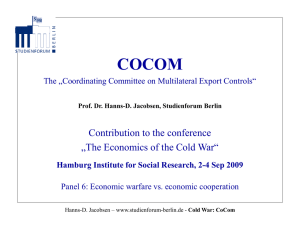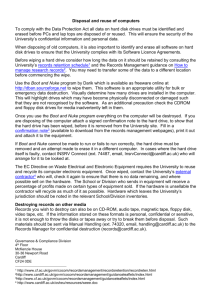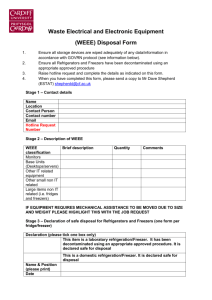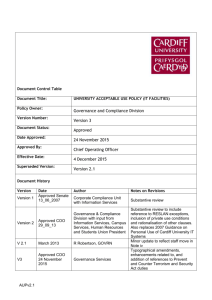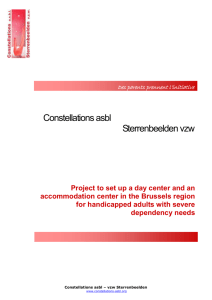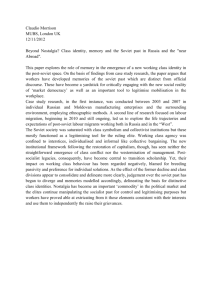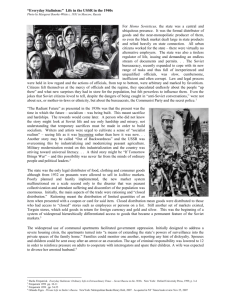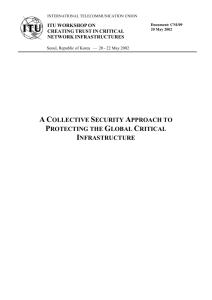5 East-West Trade in Cold War Europe: National Interests and
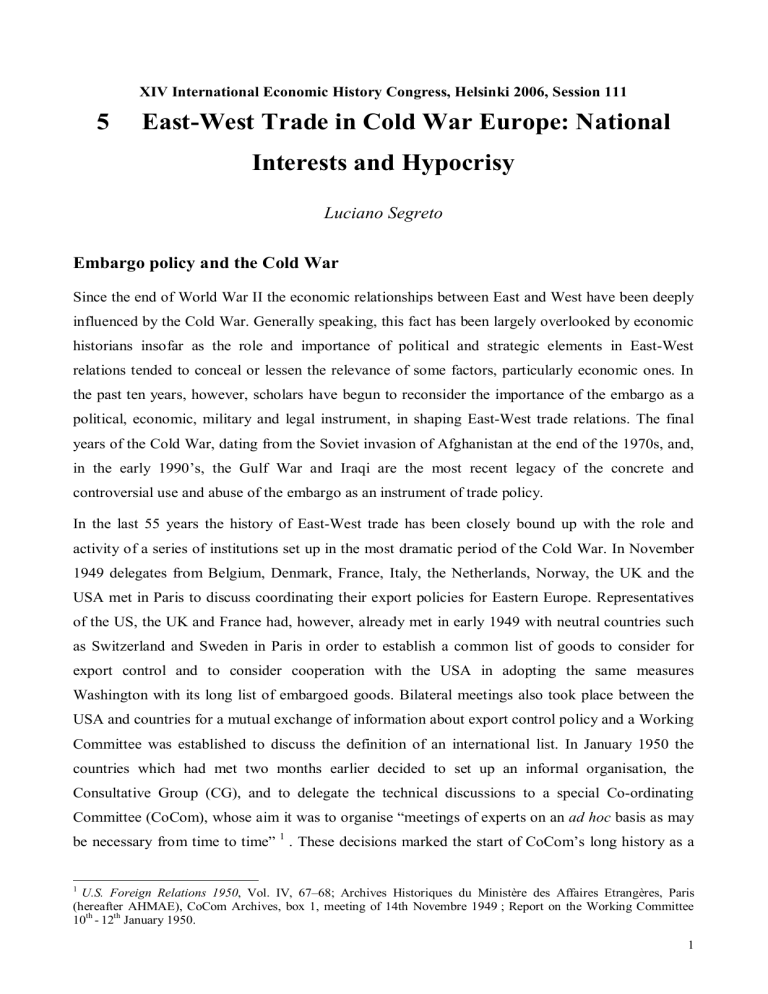
XIV International Economic History Congress, Helsinki 2006, Session 111
5 East-West Trade in Cold War Europe: National
Interests and Hypocrisy
Luciano Segreto
Embargo policy and the Cold War
Since the end of World War II the economic relationships between East and West have been deeply influenced by the Cold War. Generally speaking, this fact has been largely overlooked by economic historians insofar as the role and importance of political and strategic elements in East-West relations tended to conceal or lessen the relevance of some factors, particularly economic ones. In the past ten years, however, scholars have begun to reconsider the importance of the embargo as a political, economic, military and legal instrument, in shaping East-West trade relations. The final years of the Cold War, dating from the Soviet invasion of Afghanistan at the end of the 1970s, and, in the early 1990’s, the Gulf War and Iraqi are the most recent legacy of the concrete and controversial use and abuse of the embargo as an instrument of trade policy.
In the last 55 years the history of East-West trade has been closely bound up with the role and activity of a series of institutions set up in the most dramatic period of the Cold War. In November
1949 delegates from Belgium, Denmark, France, Italy, the Netherlands, Norway, the UK and the
USA met in Paris to discuss coordinating their export policies for Eastern Europe. Representatives of the US, the UK and France had, however, already met in early 1949 with neutral countries such as Switzerland and Sweden in Paris in order to establish a common list of goods to consider for export control and to consider cooperation with the USA in adopting the same measures
Washington with its long list of embargoed goods. Bilateral meetings also took place between the
USA and countries for a mutual exchange of information about export control policy and a Working
Committee was established to discuss the definition of an international list. In January 1950 the countries which had met two months earlier decided to set up an informal organisation, the
Consultative Group (CG), and to delegate the technical discussions to a special Co-ordinating
Committee (CoCom), whose aim it was to organise “meetings of experts on an ad hoc basis as may be necessary from time to time”
1
. These decisions marked the start of CoCom’s long history as a
1
U.S. Foreign Relations 1950 , Vol. IV, 67–68; Archives Historiques du Ministère des Affaires Etrangères, Paris
(hereafter AHMAE), CoCom Archives, box 1, meeting of 14th Novembre 1949 ; Report on the Working Committee
10 th
- 12 th
January 1950.
1
one of the most important but also of the less know Cold War institutions which officially came to an end in 1995.
2
The role of CoCom in the Cold War
In the late 1960s a young Swedish scholar, Gunnar Adler-Karlsson, published his seminal work on
East-West trade and the role of the Western embargo policy vis-à-vis the Soviet bloc
3
. At the time international relations were still influenced by the sort of factors which prevented embargo and trade policy from being treated as a purely academic issue; tensions in the Middle East, the Soviet invasion of Czechoslovakia and US involvement in Vietnam all underlined the fact that the two political hemispheres were still enemies. Thus, the impact of Adler-Karlsson’s book was limited, despite the enormous importance of much of the rich information it contained. The personal ties between Adler-Karlsson and the former head of the Executive Secretary of the United Nations
Economic Commission for Europe, the Swedish economist and Nobel Prize winner, Gunnar
Myrdal, should not be neglected when appraising the value of Adler-Karlsson’s work.
4
As a neutral country, Sweden played a delicate role in East-West relations, both from a political and an economic point of view. As a result, the scientific interest in explaining the real significance, functioning and effective outcome of the Western embargo policy was not unconnected with
Sweden’s desired role in international relations. Adler-Karlsson represented — consciously or unconsciously — a neutral standpoint on a very problematic issue. As a social scientist he considered himself politically independent in both the academic debate and the explanations he provided, and rejected any notion of “scientific loyalty” to Western “social philosophy” proposed by some American Congressmen. However, he did come out strongly against the covert presence of
CIA agents and other non-scientific representatives in, for example, universities and international cultural institutions, as shown now in the book written by Frances Stonor Saunders
5
in order to monitor politically sensitive areas, such as scholars and research centres studying the communist system and/or the East-West relations without an aprioristic or “loyalty-driven” point of view
6
.
For many years Adler-Karlsson’s work remained the most complete description of embargo policy, its institutions and instruments. New studies only appeared in the late 1970s and the 1980s, and
2
In January 1950 its members were Belgium, Canada, Denmark, France, Italy, the Netherlands, Norway, the UK and the USA; the Federal Republic of Germany and Portugal joined in 1951; Japan in 1952, Greece and Turkey in 1953,
3 and Australia in 1989 (Export Administration Regulations, Part 770.2, October 1989).
G. Adler-Karlsson, Western Economic Warfare 1947–1967. A Case Study in Foreign Economic Policy , Stockholm,
4
Almquist & Wiksell, 1968.
Gunnar Myrdal directed, encouraged, and also influenced Adler-Karlsson, as confirmed by the latter in a seminar he gave on July 7 th
2004at the University of Florence.
5
F. Stonor Saunders, The Cultural Cold War. The CIA and the World of Arts and Letters, The New York Press, New
6
York, 1999.
G. Adler-Karlsson, Western Economic Warfare, cit., p 21.
2
opened a new season of research. They had one main point in common — their focus of interest had shifted from the economic relevance of embargo policy to its strategic importance as the approach turned to terminology and concepts of political science. Technology played an important role in this context, but only as a tool to confirm or refute the political explanation. The debate was largely restricted to the USA as an opportunity to revise, also for practical reasons, US policy on the
Eastern bloc, as a leverage for introducing liberalising elements into Soviet society or “internal policies and its dealings with the outside world”
7
. The US reaction to the Soviet-Afghan war and the evolution of the political situation in Poland in the early 1980s was the central point to reconsider the efficacy of coercive tactics towards the USSR as CoCom used to be, both in the
1950s and 1980s. A reconsideration of CoCom’s first years of activity may serve as an instrument to detect the reaction of Western European governments to economic warfare, but only in the light of the comparison with the political problems then being faced by the Reagan administration in the
1980’s
8
.
In the early 1990s the declassification of US and European archives opened the door to new perspectives, although the main approach did not change dramatically. British and Scandinavian researchers were the most active and focused on the US-Britain or US-Scandinavian (particularly
Danish, Norwegian) political and economic relationships. The British studies emphasised the special relationships between the two English-speaking countries, and the consequences for their political and economic relationships arising from the discussions in and around CoCom. As Alan
Dobson clearly put it, the economic approach to special Anglo-American relationship was normally confined to a secondary position, if not altogether neglected
9
. His study tried to revitalise this aspect of the old theme in the research in diplomatic history, highlighting its ups and down especially during the 1950s, and using CoCom disputes as an element in examining the strategic cohesion between the two countries. He demonstrated how the special relationship often faced critical moments, especially during the fifteen years following the end of World War II, and that CoCom was frequently one of the reasons for the development of very divergent points of view on many aspects of international relations. Nevertheless, Dobson’s approach was rooted in the dynamics and explanations of high-level political relationships (government to government, Prime Minister to
7
See for example J. F. Bucy, “Technology Transfer and East-West Trade: A Reappraisal ” , International Security , No.
5, 1980/81, p. 145.
8
M. Mastanduno, “Trade as a Strategic Weapon: American and Alliance Export Control Policy in the Early Postwar
Period ” , International Organization , 42, 1, Winter, 1988.
9
A. Dobson, “The Kennedy Administration and Economic Warfare against Communism ” , International Affairs ,
No. 64, 1987/1988; id., The Politics of Anglo-American Special relationships 1940-1987 , Brighton, Wheatsheaf, 1988.
3
President), thus confirming the importance of the diplomatic approach to embargo policy and, more generally, Western strategic export control policy.
The approach proposed by Helen Leigh-Phippard is similar. Her study, mainly based on the Foreign
Office documents, links US embargo policy and Anglo-US discussion on the shift from civil to military US aid in the 1950s
10
Even more “Anglocentric” were the articles by Frank Cain, which focussed on the British interpretation/response to the creation of CoCom, which was treated as a sort of American decision, while the interest shown in the CoCom Committee for Communist China (CHINCOM) set up in
1952, opened up new research perspectives. Nevertheless, the politico-diplomatic and, in the last instance, the strategic approach remained predominant
11
(Cain 1994, 1995).
In the 1990s the new waves of studies included contributions which extended the problems connected with CoCom to the Scandinavian area, particularly Denmark, Norway and Sweden.
12
As periphery area of Western Europe, Scandinavia was only marginally involved in the first phase of the Cold War, and even the Korean War appeared not to have marked consequences for its national economies. The studies on this area did not mark a clear turning point, as they confirmed the politico-strategic approach, but they were nevertheless still particularly important. The introduction of other dynamics in the discussions among Western countries, until then limited to the Anglo-US disputes, allowed policymakers and researchers to consider CoCom from a different perspective.
The “Big Three”, the USA, the UK, and France, were only able to control the discussion and to carry on strategic decisions in a very limited way. In particular, the USA was faced with the political, and economic, costs of exercising hegemony and discovered that the debate in the Western camp could reach an unexpected level of critique of the leading country in this alliance
13
. The problem of the difference between Western strategic interests in general and national (political and/or economic) interests was mentioned, and indirectly it was placed on the agenda for future research.
10
H. Leigh-Phippard, “US Strategic Export Control and Aid to Britain, 1949-1958”, Diplomacy and Statecraft, vol. 6,
No. 3, November 1995
11
F. M. Cain, “Exporting Cold War: British Responses to the USA’s Establishment of COCOM, 1947–1951 ” , Journal of Contemporary History , No. 29, 1994; id., “ US Led Trade Embargo on China: The Origins of CHINCOM, 1947–
1952”, The Journal of Strategic Studies , Vol. 18, No. 4, December 1995.
12
Although never a member of CoCom, the latter was regularly approached by the USA and many other participating countries in the hope it lend support to the embargo policy.
13
T. E. O. Foerland, “An Act of Economic Warfare? The Dispute over NATO’s Embargo Resolution, 1950–1951”,
The International History Review , XII, 3, August. 1990; Id., ‘‘Selling Firearms to the Indians’: Eisenhower’s Export
Control Policy, 1953–1954 ” , Diplomatic History, XV. 1991; Id., Tugs of Economic Warfare: the Creation and Prime of
CoCom, 1948–1954 , Ph.D. Thesis, University of Oslo, 1991.
4
In a study dealing with Denmark and the Marshall Plan, another Scandinavian scholar, Soerenson, confirmed the main points which already emerged in the first work dealing with this area
14
. Her contribution was even more important because some years before the publication of the works cited above she confirmed the utility of Adler-Karlsson’s classical argument that considerations of economic and military aid determined Western European countries to accept economic warfare in the period 1950–1953/54. Using the first declassified documentation from the British Public Record
Office on CoCom and the Consultative Group, Soerenson revealed how the British rejection of economic warfare as a strategy for USSR containment was directly connected to the British economy’s dependence on East-West trade. As a result, the British decision to accept the US embargo policy in 1950–51 was not the result of a change in strategic thinking, but the consequence of the decision made by the US Congress to link strictly military aid to East-West trade. Although
Soerenson’s work did not focus on the use of the concept of “economic warfare”, considering without hesitation that the US strategy was from a historical point of view a good exemplification of that concept, a new approach linking closely national economic interests (and their evolution), and the constraint of the US and/or Western strategic interests, was now available. The economic reasons for accepting or refusing US policy were the central point of this research, which unfortunately remained an exception in the international literature on CoCom
15
.
The collapse of the Soviet Union and the Soviet bloc brought about a new and controversial generation of Cold War research. Discussions included almost all the most important scholars working in the field, representing at times quite differing visions of the theme. The literature completely ignored CoCom and its relevance for the connection between civil and military aid, as well as for its interrelation with the definition of the concept of national interest and its possible contradiction with the strategic aims of the Western alliance. From Leffler to Hogan and Gaddis and
Westad, none of the most prestigious US and non-US Cold War historians wrote a single word about strategic Western export control and CoCom and tended instead to limit themselves to the
“classical” significance of the Cold War
16
14
V. Soerensen, Social Democratic Governmentin Danmark under the Marshall Plan 1947–1950 , unpublished Ph.D.,
Florence, European University Institute, 1987.
15
Ibidem; id., “Economic Recovery versus Containment: The Anglo-American Controversy over East-West Trade,
1947–1951”, Cooperation and Conflict , XXI, 1989.
16
M. P Leffler, A Preponderance of Power. National Security, the Truman Administration, and the Cold War , Stanford,
Stanford University Press, 1992; Hogan, America and the World. The Historiography of American Foreign Relations since 1941 , Cambridge, Cambridge University Press, 1995; J. L. Gaddis, We Now Know. Rethinking Cold War History ,
Oxford, Oxford Unievrsity Press, 1997; O. A. Westad, (ed.), Reviewing the Cold War. Approaches, Interpretations,
Theory , London, 2000
5
Even less comprehensible was the book written by Diane Kunz and reviewed by John Lewis Gaddis as “a comprehensive history of United States foreign economic policy”. Here, for instance, Harold
Stassen, who ran in the 1950s the MSA and the Foreign Operations Administration, two key federal agencies for the implementation of US foreign economic policy, is referred to only once, and then only as “a putative Republican candidate in 1948”. The book does not say a word about the discussions on CoCom, its relationships with US military aid, and the rather crude discussions between the US and Western European governments on the effects for the latter of the embargo policy on goods for East-West trade
17
.
In contrast there is the approach of a more recent publication by Ian Jackson , whose interpretation of CoCom activity is connected with a broader and original vision of the Cold War, including its economic dimension. Jackson explores the US and British archives to reveal how the trade diplomacy of the two countries was based on differing opinions about the Soviet Union. The commercial and strategic perceptions of the leading power of the Eastern bloc were so divergent that in the 1950s and early 1960s the relationship between Washington and London was frequently characterised by friction and conflict, and this only subsided with the onset of the Kennedy administration. Although the Anglo-American focus is still too central, the real innovative approach to CoCom, while the non-diplomatic or non-strategic considerations begun to appear in a new light
18
.
More recently, Alan Dobson examined the broader period of 1933–1991, and revealed how the US policy of economic statecraft was an integral part of its foreign policy and designed to ensure the survival of the USA “in the face of vital threats to its security”.
Despite the observation that the economic statecraft has in general and in particular for the American foreign policy, his approach is mainly focused into the analysis of the policy decision process at the highest level. Nevertheless, he offers not only a new and precise general overview to all the embargo policy, but also highlights the difficult compromise between US government and its allies all throughout the period ”
19
.
A proposal for a new approach
The opening up of CoCom archives and the increasing availability of new documentation in many
European and US archives allows us to reconsider the study of CoCom from a range of perspectives. It should now be possible to verify non only the state of US-European political and economic relationships in the 1950s and 1960s, but also the effectiveness of CoCom embargo
17
D. Kunz, Butter and Guns. America’s Cold War Economic Diplomacy, New York, The Free Press, 1997
18
I. Jackson, The Economic Cold War. America, Britain and East-West Trade, 1948-63, London, Palgrave, 2001.
19
A. P. Dobson, US Economic Statecraft for Survival 1933-1991. Of sanctions, embargoes and economic warfare,
London, Routledge, 2002.
6
policy, the relationships between European (and perhaps US) governments and the economic and social pressure groups which were at times a decisive actor in the development of East-West trade, and last but not least to study, at least partially, the complex structure set up by both Soviet bloc governments and many Western businessmen to reduce the effects of the embargo.
I intend to expose the possible advantages of a different and more complete approach to the history of CoCom and its policies taking into consideration the economic and business history of each of the participating countries in order to understand the real trajectories of this informal institution. Let us consider the following seven points.
Firstly, CoCom was basically a technical body, where more general political and/or strategic discussions were an exception. Thus, attention should be paid to the concrete elements on which the discussion was based, as these indicate that beyond technical disputes there were concrete national economic interests at stake. For instance, the duration of a machinery, its fastness, its technical flexibility were all indirectly elements qualifying the different national industrial apparatus of the participating countries. The relevance of the discussions and the governments which participated indirectly, may be indicative of the level of technological development reached in each country.
Secondly, the technical discussions among the representatives, and at times experts, of the participating countries on the embargo or restricted goods lists and their eventual elimination or substitution in the CoCom lists, needs to be set against the economic and strategic background of the actual performance of the economy and especially of the industrial sectors in the Soviet bloc.
US and British intelligence were the most organised in supporting their countries with ‘on the ground’ information, but many different intelligence institutions were involved in this activity, and their perceptions of the Soviet industrial and military complex and the level of technological development attained in the Soviet bloc did not always concur. Both political and national reasons differentiated a great deal over intelligence In many cases, as far as Soviet technological development is concerned, US and British intelligence reports revealed the existence of what appeared to be two different countries: generally more advanced for British intelligence, and more backward for US intelligence. The difference was not without consequences for CoCom, as the first approach opened the door to more trade, including many goods under embargo, whilst the second insisted on the need to confirm, and even increase, the technological gap between the Western economies and their Soviet counterparts.
Thirdly, underlying these two approaches one can detect different national economic interests, especially on the British side. Many other European countries, which probably found the British analysis more realistic, and certainly more attractive, frequently adopted the latter approach. The
7
opportunity to accede to exports depended on the technological level and industrial productivity of the country concerned. Thus, the discussions never were purely “scientific” and hence lacked any considerations (real or potential) of national economic interest. If a country did not participate in this kind of discussion it meant that it was unable to intervene on export issues. However, a country may confirm its disagreement with changes to the embargo or restricted goods lists in order to prepare the ground and the tactical alliance for the discussion on another good, where it was supposed to have some interest.
Fourthly, the embargo and restricted lists policy thus opened the door to competition among
Western European countries, because the former system, especially the quota system, had tended to artificially limit competition. Thus, other countries, which could easily have been beaten in open competition among Western countries, became suppliers of Eastern European countries, creating better conditions in the long run for real competition with the countries historically better placed in
East-West trade for certain goods. This situation clearly caused problems for the US capability to impose their preferences on East-West trade policy among the other countries.
Fifth, an examination of CoCom exception procedures for exporting goods on the lists to the Soviet bloc if the quid pro quo criteria afforded the Western country a realistic advantage in export-import relations with the Eastern European country, indicates directly and indirectly, the powerful force exerted by pressure groups. Trade unions, industrial groups and representatives, local authorities and political parties were amongst the most active in promoting trade with the Soviet bloc. The main defence of such trade was based on purely economic grounds, that is where the conditions prevailing in a particular Western exporter country were such that failure to deliver a major supply to some Eastern European country would lead to a dramatic increase in unemployment and the likelihood of an economic, social, and political crisis. This part of the study illustrates the absurdity of the CoCom system, because following the rules established altogether, the exception procedure, once accepted, allowed a country to export strategic goods on the list in exchange for “counterparts essential for maintaining its economy and consequently to increase its productivity as well as for pursue its defence effort”. In a rather complicated way it could be said that the Soviet bloc actually helped the Western world in its attempts to defeat it. Forms and procedures were perfect, pace
USA.
In the sixth place, the business history approach applied to the pressure group question allows us to broaden the picture to non-industrial sectors, such as shipping, insurance, finance issues such as export credits which were normally a secondary element in the export chain, but sometimes of vital importance for its success. In some countries, such as Belgium and the Netherlands, the economic
8
and political strength of this segment of the business community was extremely important – and politically influent - , given the geo-economic structure of the countries and their international competitive advantage in these sectors.
Finally, an economic approach to the CoCom question allows us to reconsider many other aspects connected with the general topics of economic and trade liberalisation and the setting up of new preferential economic and trade areas (EEC and EFTA). The impossibility of re-establishing former levels of economic relations with Eastern European countries, at least in some specific sectors, gave another major impetus to the search for a preferential area where economic development, security and welfare could be obtained without abandoning the US appeal for a new international economic order. In CoCom much of the debate highlighted this search for “another” area where exports diverted from their “natural” and historical goal (Eastern Europe), could finally find the sort of market which could absorb the levels of production permitted by the introduction of the US productivity approach.
New evidence
In a 1966 memorandum to President Lindon B. Johnson from the Defence Secretary, Cyrus Vance and State Department Secretary, George Ball, the US acknowledged that “the CoCom selective embargo has little effect on the rate of economic growth or military capabilities of the Soviet Union or other Warsaw Pact nations. Our unwillingness in the past to agree to a selective application and downward revision of this list has been a source of irritation not only in Eastern Europe, but also among other CoCom countries”. This was not the first time that US officials had expressed such an opinion, but it was probably one of the first times that this sort of opinion was submitted to the
President’s point of view, albeit in the context of the study of measures to increase the cohesion among NATO countries
20
.
In 1958, when CoCom was discussing the second major revision of its lists, a more articulated vision was circulating among the US administration. The USA had begun to reconsider their position in CoCom, by accepting the fact that the Soviet Union had made considerable achievements in strategic weapons in the previous eight years, when CoCom already existed and its strategic control policy was already in force. Western European countries participating in the embargo policy were increasingly reluctant to subscribe to “a system of controls […] based on the
20
National Archives and Record Administration, College Park, MD (hereafter NARA), RG 59, Records of the
Department of State, Lot File 69D 150, Box 7, Memorandum for the President, Measures to increase Cohesion of
NATO, Final Response to NSAM 345, 3rd June 1966.
9
assumption that denial of listed commodities to the Soviet bloc [had] an effect on military preparations of war potential”. Especially since 1954, when Soviet possession of hydrogen bomb became known, these countries developed the concept that “a trade control based on concepts of conventional warfare [was] an anachronism in an age of nuclear weapons and guided missiles”
21
.
This opinion was the basis for the first major reduction of the 1950 CoCom lists.
Even four years before, when the embargo policy was inaugurated, the discussions were already quite frank. The approaches of the European countries and USA were quite different. Since the onset of discussion within CoCom different political positions emerged. In Western Europe the prevailing idea was that control should be limited to goods which directly contributed to the Soviet war potential, whilst the US government argued that controls should cover anything that contributed significantly to the reinforcement of the Soviet bloc’s industrial base. The consequences of these different strategic approaches was that European countries participating [in CoCom] were in favour of selecting a few key products, whilst the US preferred a [long and] detailed list
22
Whilst these disagreements did not inhibit the achievement of the US strategy, i.e. the formulation of a common export control policy, they remained a second best or an “arrière pensée” of many
European countries. At that time their economies did not allow them to apply a radically different strategy. Their dependence on US economic and financial assistance was the basis for their position in CoCom. The Kem amendment, voted by the Congress in 1951, allowed the US government to suspend aid to countries trading embargoed goods or other commodities on the CoCom lists with the Soviet bloc, but was merely the formal sanction of this unbalanced situation
23
.
Echoes of the discussions in Congress and within US public opinion regarding Senator J. P. Kem’s proposals also reached the Consultative Group and later CoCom. The consequence was an increase of US pressure to homogenise the international list with the larger American one, and the decision to clarify the procedures for the goods in list II (quantitative control), and especially for the principles and procedures on exceptions. The Korean War helped reduce the differential in many aspects of CoCom policy, but it was only a short parenthesis. The sustainability of a situation where the USA, the UK and France appeared to be the real policy-making powers, with CoCom acting merely as a consultative group, receiving the proposals of the Big Three, was not very great
24
.
In a sense CoCom operated on a razor edge with a very political delicate equilibrium, because the principle of unanimity was often used by smaller countries or countries such as Germany or Italy
21
NARA, RG 59, Records of the Department of State, Central Decimal File, 1955–59, 460.509/9–1157.
22
AHMAE, CoCom Archives, box 5, Report by the CoCom to the Consultative Group, 25 th
May 1950.
23
G. Adler-Karlsson, Western Economic Warfare , cit. p. 27
24
AHMAE, CoCom Archives, box 1, meeting of the Consultative Group, 19 th
-20 th
July 1951
10
(which were in a different position with respect to other CoCom countries),
25
to reinforce their national interests. This new situation tended to confirm European concern as to their ability to develop an autonomous position in East-West trade. In the meantime, however, this did not preclude having a different point of view on a wide range of questions connected with export trade control and CoCom rules.
Indeed, even the history of CoCom in the 1950s is full of examples which indicate that the cohesion of this Cold War institution was less strong than one might imagine. The main method used by
Western European countries to counterbalance CoCom’s strict rules for export controls was to request exception procedures. In July 1951 the Consultative Group had stressed the need to find a compromise between the economic needs of the West and its security issues when trading with the
Soviet bloc. However, it was only in September 1952 that a first draft resolution on procedures for exception was discussed. The time gives us some idea of the difficulties in reaching an agreement on such a controversial question, which risked undermining CoCom policy from the outset. For example, in 1950 and 1951 Italy alone submitted 51 requests for ball-bearings, (but in a sense this too constituted an exception, and in any case only a few of them were accepted). In 1952, total exports of goods in List I amounted to 5,697,370 US$, those in List II to 38,018,704 US$, and those in List III to 110,010,834 US$.
26
In 1953 the request for a new exception by Italy (once again for ball-bearing), highlighted the differences among the CoCom countries. Italy requested that the allies consider the risk of increasing unemployment in the area where the items were produced if the exports to the Soviet bloc were prohibited. The German delegate, on the other hand, requested precise statistics on unemployment, refusing to accept a good balance between security and unemployment on the basis of an assumption
27
CoCom’s determination was also attacked from another angle. In 1952 the Soviet government organised an economic conference in Moscow in order to offer new trading opportunities to the
West. The Western governments did not send an official delegation, but many western businessmen and economic associations attended the meeting, considered by CoCom as a new economic tactics of the Soviet authorities to divide the Western countries. The Soviet countries also used the UN
Economic Committee for Europe to develop the same kind of strategy. In spring 1954 an economic
25
The geopolitical position of Western Germany in Europe, and its “special relationships” with the German Democratic
Republic, are self explanatory, whilst Italy, the other defeated country of World War II, had the chairmanship of
CoCom since the beginning of its activities.
26
AHMAE, CoCom Archives, box 40. The biggest exporters were the UK, with almost 100 m. US$ (over 96% in List
III), three-quarters of which were re-exports; Italy with over 13.1 m. US$ (approximately 65% in List II and 30% in List
III); and the Netherlands with 11.7 m. US$, almost all in List II.
27
AHMAE, CoCom Archives, box 40, Doct 1255, 4.7.1953, discussions on 19 th
, 23rd June, and 1 st
July 1953.
11
conference on East-West trade took place in Geneva, and once again the Soviet proposal was presented in more official terms.
In August 1954, following a year of pressure from many European countries and especially from the national business communities, which insisted with their respective governments to reconsider the embargo policy, CoCom agreed to a first revision of the embargo lists. The total number of goods on the three lists was reduced from about 450 to 250 items
28
. However, the compactness of
CoCom was seriously weakened by the fact that the new lists were the fruit of an agreement reached outside CoCom by the USA, France and the UK
29
As a result, instead of reducing the requests for exceptions, the new situation increased the use of this procedure. Between March 1954 and March 1956 the total number of accepted exceptions reached 30 cases (13 were for Western
Germany, 7 for Italy, 3 for the UK), and in the following 12 months another 39 exceptions were accepted (16 for the UK, 9 for Western Germany, 6 for the Netherlands, 4 for France). In the following years this phenomenon reached impressive proportions, and between 1957 and 1959 the special cases totalled 365, and for the first time US delegates acceded to the procedure in a significant proportion (149 for the UK, 74 for Western Germany, 37 for the USA, 36 for France, 27 for Italy)
30
In 1958, pressure to redefine the rules governing exception procedures led to an important success.
An English memorandum proposed that exceptions be ratified where a risk of serious damage to economic prosperity or political stability of a participating country existed. During the discussion that followed, the Italian delegate proposed adding the word “social” as another context where the wellbeing of a country could be affected, soon followed by the Belgian, German and Danish delegates. This opened the door to a more flexible interpretation of the grounds for an exception procedure, although whether potential economic, political or social damage was to be considered only at a national level, and not also at a local or regional level, remained unresolved. In practice, the latter cases were frequently mentioned given the development history of certain industrial sectors which were concentrated in some countries only in specific areas
31
.
This solution was finally accepted by all participating countries, but without the necessary unanimity. The evaluation of the range of factors (damage for the requesting country on the one
28
G. Adler-Karlsson, Western Economic Warfare , cit., p. 143.
29
AHMAE, CoCom Archives, box 66, CoCom Doct Nr. 2409, 7 th
March 1957, Record of discussions on M. D’Orlandi relinquishing chairmanship of Co-ordinating and China Committee (28 th
February and 5 th
March 1957).
30
AHMAE, CoCom Archives, box 10, CoCom Doct 2000, 30.4.1956, CoCom - Report to the Consultative Group by the Chairman of the CoCom covering the period 6.3.1954-5.3.1956; CoCom Doct 2500- Report to the Consultative
Group by the Chairman of the CoCom covering the period 6.3.1956-5-3-1957; box 76, CoCom Doct 3000, CoCom –
Report to the Consultative Group by the Chairman of the CoCom covering the period 6.3.1957-15.8.1959.
31
AHMAE, CoCom Archives, box 75, Doct CoCom 2869.75, 17 th
December 1958, Discussion about the exception procedures.
12
hand and the strategic situation on the other), was a CoCom prerogative, but the Danish representative affirmed that evaluation of the strategic character of exported goods was of the single countries. The French delegate completed this position, by giving it a more general significance: the problem included an aspect connected with national sovereignty, which the French were not ready to forgo. This position was not surprising. France had the political courage to clearly express this opinion, largely accepted by other European countries
32
. Other countries, such as Western Germany pushed the opportunities offered by the new definition to their logical extreme. Thus, the exception procedure was invoked not only to guarantee raw materials for specific industries, such as Czech kaolin for Bavarian enterprises, but the quid pro quo policy was also considered as favouring the
“reinforcement of the strategic potential of the Free World”, because in exchange for goods on the embargo list (ball-bearings or refrigerators ships) the Soviet countries were offering gasoline, manganese, cotton, antimony, wheat, tobacco and wood. The chef d’oeuvre of the Western
European countries’ defence of national interests was thus completed: thanks to CoCom policy the
Soviet bloc was in effect helping its enemy strengthen its own economic and military structure
33
.
This was a good example of the criticism made by CoCom’s chairman, when he complained of the contradictory behaviour of some governments, which on the one hand invoked the specific situation to justify the elimination of a certain good from the lists or to support a request for an exception, whilst simultaneously refusing the validity of analogous considerations in more general fields. That is, governments should be ready to share a common trade policy when dealing with the Soviet bloc, but would not agree to take into account the economic situation of particular CoCom countries when the discussion touched on goods where they did not have a particular national interest
34
At other times the differences - and competition - among Western European countries emerged more clearly. Discussions on quota policy (a single quota for all Soviet countries, China included, or a quota for each country?) divided CoCom: the US were against the one-dimensional nature of the quota policy, whereas the UK wanted to differentiate China from the rest of the Soviet bloc, and
Canada, Italy, Japan, Western Germany, Denmark and France were against any differentiation among Eastern bloc countries. Subsequently, the positions changed again, because some countries, such as Italy and Japan, preferred national quotas, which allowed them to enter the Soviet bloc
32
AHMAE, CoCom Archives box 75, Doct CoCom 2869.79, 19 th
January 1958; Doct CoCom 2869.80, 26 th
January
1959; for the conceptual framework for this problem see A. Milward et al., The frontier of national sovereignty, Theory and history, London, Routledge, 1992.
33
34
AHMAE, CoCom Archives, box 55, CoCom Doct CoCom 1170, German Memorandum, 12 th
AHMAE, CoCom Archives, box 14, Secretariat Doct 48, 10 th
November 1954.
January 1955, Memorandum of the Chairman of
CoCom.
13
market, an opportunity which would otherwise have been very difficult to obtain with a single quota for all Eastern European countries
35
Other examples are the tranship question or the construction or repairing of shipping for the Soviet bloc. Here too discrepancies appeared along the lines of differing national interests. Transit controls were necessary to avoid the diversion of goods to the Soviet bloc, but its implementation sometimes required the approval of specific national legislation (as in the case of Italy), and the reinforcement of control procedures. The main difference emerged between countries calling for physical controls and others that opted for more rigid administrative controls. Apart from this distinction, there were different opinions about the need to include into the discussion ports in Algeria, Morocco and
Tunisia (often used by French shipping companies), or the English controlled port of Gibraltar or
Malta (where the English reported that there was presence of smuggling or diversion to the East
Bloc). The difficulty of reaching an agreement on this issue reflected the increasing competition among the Mediterranean ports of CoCom countries, which were concerned about the growing importance of other ports in Spain (Barcelona), Africa (Algeciras, Tangier), Israel and Lebanon
36
..
The question of accepting the Eastern bloc countries’ request for reparation of old ships or the construction of new ones divided the CoCom countries between those with a shipyard sector in crisis (Italy, Denmark, the Netherlands), and those where the sector was relatively healthy. The former were more reluctant to turn down the opportunity of work for national shipyards, whilst the latter favoured a more selective acceptance of the opportunity, considering the technical and economic profile of the request, not to mention its military potential, coming from an Eastern bloc country. Here again there were strategic considerations at work, often mixed with technological issues, which could be invoked to avoid a CoCom refusal to admit the exception. For example, the
British agreed to sell the Polish government a new ship without its radar system, which they considered the only strategic item on the vessel. At the same time, however, the British voted against a Danish request to CoCom to authorise the export of a second-hand ship to Poland which would allow the Danish government in order to avoid to paying for imports of Polish coal in sterling or dollars
37
.
The general problem underlying the balance of payments question posed by the Danish government was frequently used by the Western European countries to justify their export-import policy with the Soviet bloc, and was almost always accepted. Indeed, the CoCom system ran into problems
35
AHMAE, CoCom Archives, box 70, Doct 2657, Discussion on the lists, on 4 th
, 8 th
, 9th, and 11 th
October 1957
36
AHMAE, CoCom Archives, box 53, Doct 1654, Enforcement procedures, Discussions of 1 st
, 2 nd
, 3 rd
, 9 th
, 10, 11 th
June
1954.
37
AHMAE, CoCom Archives, box 50, Doct 1588, Danish memo, 14 memo, 28 th
May 1954.
th
May 1954; Doct 1607, discussion on the Danish
14
whenever the discussion shifted from specific topics to general economic issues such as monetary policy, balance of payment status, or trade policy. It is true that CoCom dealt with strategic export controls, but export policy to the Soviet bloc could not be separated from the general trade policy of each participating country. The latter in turn could not be separated from the balance of payment question and other economic and monetary agreements which linked up the Western European countries, such as the European Payments Union, trade liberalisation and legal aspects of the trade policy such as the most favourite clause, which was often invoked by Eastern European countries in the hope of limiting the effects of the embargo policy. However, every time CoCom became involved in a more general discussion, many countries - first and foremost the USA - remembered that the institution, like the Consultative Group, was a technical rather than a political body. Thus, the call by CoCom’s chairman in late 1954, for details of the participating countries’ trading agreements with the Soviet countries, on the assumption that Eastern bloc trade policy was based on political and military imperatives and that CoCom policy needed to examine the Eastern bloc trade tactics, did not elicit a sufficiently positive response from national delegates, with the exception of
Western Germany, Belgium and Italy. Thus, the destiny of CoCom was in a sense predetermined.
Referring to the items in the first lists, CoCom’s chairman declared that it had “examined in detail
400 hundred trees without a general vision of the wood”
38
. Thus, the contribution of CoCom to a reduction or restriction of the Soviet warfare and industrial potential was limited, whilst it simultaneously allowed a reasonable defence of national interests within the framework of the
Western alliance.
38
AHMAE, CoCom Archives, box 14, Secretariat Doct 47, 10 th
January 1955, CoCom, Memorandum of the Chairman, cit.
15
